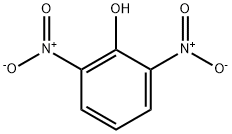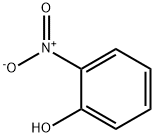2,6-DINITROPHENOL
- CAS No.
- 573-56-8
- Chemical Name:
- 2,6-DINITROPHENOL
- Synonyms
- 2,6-EXJF;BETA-DINITROPHENOL;2,6-dnp;Nsc 6215;AURORA 6895;o-Dinitrophenol;2,6-Dinitrofenol;HydrazoneDinitro;2,6-DINITROPHENOL;AKOS BBS-00008120
- CBNumber:
- CB9135011
- Molecular Formula:
- C6H4N2O5
- Molecular Weight:
- 184.11
- MDL Number:
- MFCD00024235
- MOL File:
- 573-56-8.mol
| Melting point | 61-63 °C(lit.) |
|---|---|
| Boiling point | 318.03°C (rough estimate) |
| Density | 1.7195 (rough estimate) |
| vapor density | 6.35 (vs air) |
| refractive index | 1.4738 (estimate) |
| solubility | Sparingly soluble in water; soluble in ethanol, chloroform, ether |
| pka | 3.69, 3.7, 3.5(at 25℃) |
| form | crystals |
| color | Yellowish |
| PH Range | Colorless (1.7) to yellow (4.4) |
| Water Solubility | 314.9mg/L(15 ºC) |
| Merck | 14,3282 |
| BRN | 1913410 |
| Stability | Light Sensitive, Possibly Shock Sensitive |
| Major Application | Energetic materials, battery, lubricants, curing agents for epoxy resins, fungicidal, herbicidal, food storage, drugs |
| CAS DataBase Reference | 573-56-8(CAS DataBase Reference) |
| EWG's Food Scores | 1 |
| FDA UNII | F4QM4I92KC |
| EPA Substance Registry System | 2,6-Dinitrophenol (573-56-8) |
SAFETY
Risk and Safety Statements
| Symbol(GHS) |    GHS08,GHS09,GHS06 |
|---|---|
| Signal word | Danger |
| Hazard statements | H411-H373-H331-H311-H301 |
| Precautionary statements | P280-P302+P352-P312-P322-P361-P363-P405-P501-P260-P314-P501-P264-P270-P301+P310-P321-P330-P405-P501-P261-P271-P304+P340-P311-P321-P403+P233-P405-P501 |
| Hazard Codes | T,N |
| Risk Statements | 23/24/25-33-51/53-50/53 |
| Safety Statements | 28-37-45-61-36/37 |
| RIDADR | UN 1320 4.1/PG 1 |
| WGK Germany | 3 |
| RTECS | SL2975000 |
| HazardClass | 4.1 |
| PackingGroup | I |
| HS Code | 29089990 |
2,6-DINITROPHENOL Chemical Properties,Uses,Production
Chemical Properties
Light yellow crystalline
Uses
2,6-Dinitrophenol is an aromatic nitrophenol.
Definition
ChEBI: 2,6-dinitrophenol is a dinitrophenol.
General Description
Yellow crystalline solid with a sweet musty odor. Sinks and mixes slowly with water.
Air & Water Reactions
Mixes slowly with water.
Reactivity Profile
2,6-DINITROPHENOL can detonate or explode when heated under confinement [USCG, 1999]. Phenols do not behave as organic alcohols, as one might guess from the presence of a hydroxyl (-OH) group in their structure. Instead, they react as weak organic acids. Phenols and cresols are much weaker as acids than common carboxylic acids (phenol has Ka = 1.3 x 10^[-10]). These materials are incompatible with strong reducing substances such as hydrides, nitrides, alkali metals, and sulfides. Flammable gas (H2) is often generated, and the heat of the reaction may ignite the gas. Heat is also generated by the acid-base reaction between phenols and bases.
Health Hazard
INHALATION, INGESTION AND SKIN ABSORPTION: Headache, anorexia, nausea, vomiting, abdominal pain, diarrhea, fever, pain in chest, difficult breathing, profuse sweating and thirst, dizziness and fatigue. SKIN: Discoloration and irritation. Corrosive to skin.
Purification Methods
Crystallise it from H2O, aqueous EtOH, *C6H6/cyclohexane, or *C6H6/pet ether (b 60-80o, 1:1). [Beilstein 6 III 867, 6 IV 1383.]
2,6-DINITROPHENOL Preparation Products And Raw materials
573-56-8(2,6-DINITROPHENOL)Related Search:
1of4







